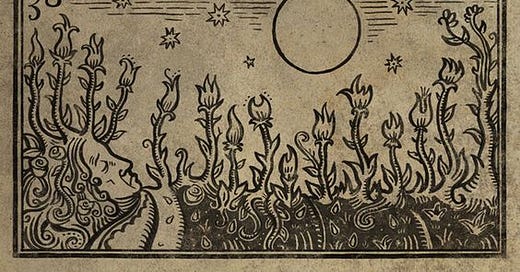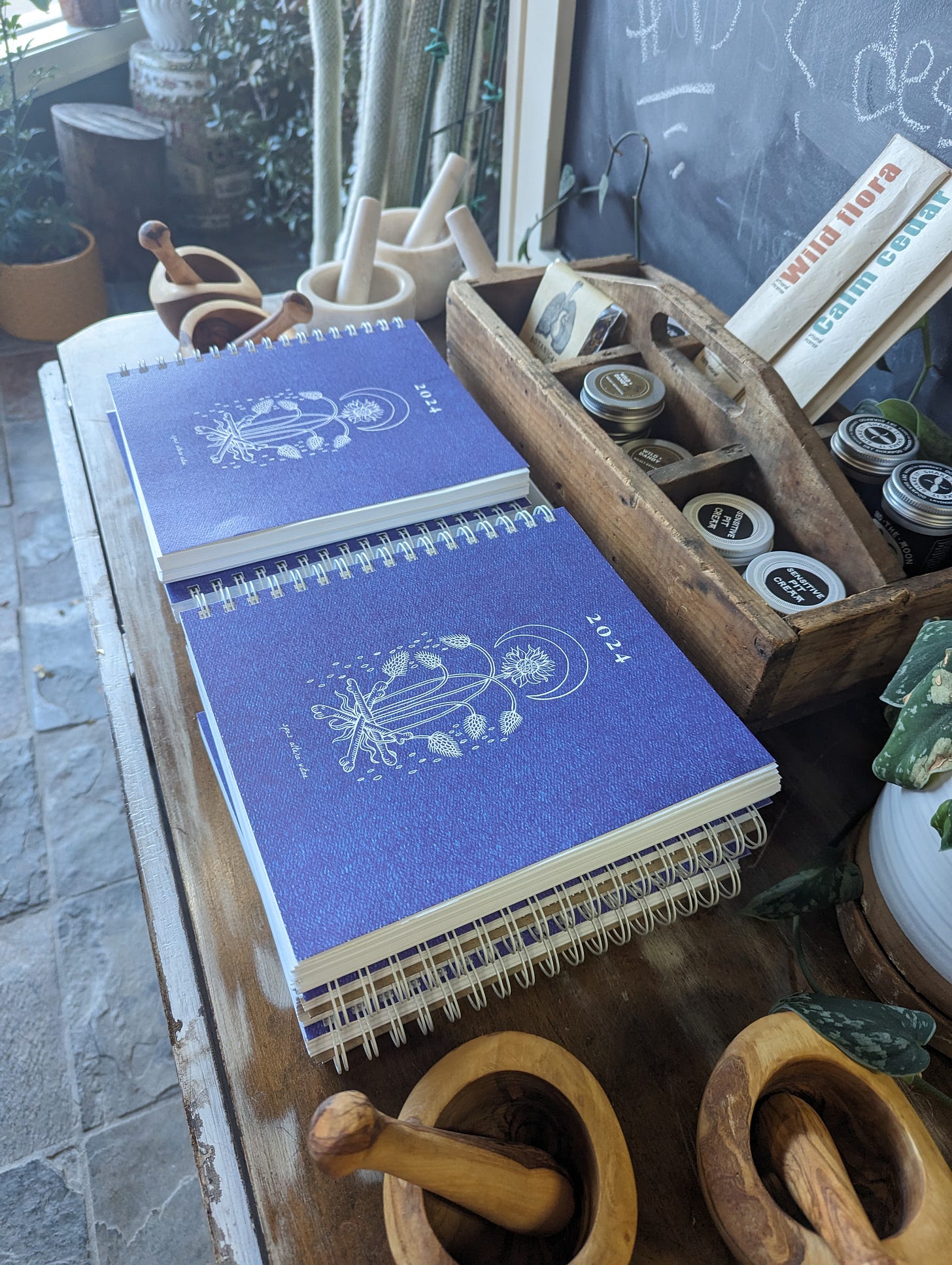Apothecary News: we are finally caught up with shipping out all pre-orders of the planner! I hope you enjoy this edition, and would love to know what you think. The planners are now also in the brick and mortar store in Gladwin, MI.
In the previous newsletter, we started exploring the archetype of witch in relation to plants. This week we will go deeper, to the bitter beginnings of both.
The newborn stage of earth was nothing but barren rock and tumultuous seas until our future ancestors crawled up out of the tide pools in the liminal space between the above and below. The green things spread across this canvas, creating blankets of lush moss that eventually spanned the earth.
It brings to mind the Slavic origin story (at least one version of it) where Rod, the ultimate force of the universe, created a divine egg from the void and left it on earth. When the egg cracked, out from it spewed Svarog, the god of fire and the forge. With him flowed waves upon waves of sea, plants, soil and the world tree.
It makes me wonder if anyone has looked for this origin point, or if that is even possible. Where did that first inch of life break free from the sea. Where did the divine egg let loose its yolk. Was it on the east coast of the supercontinent Pangea, in the Tethys Ocean near what is now Africa and Eurasia? Or was it on the west coast along the Panthalassa Ocean near current day North and South America? What little inlet holds that secret? The womb of the world.
Regardless of the mystery, life forged forward. Horsetails and ferns grew to the heights of buildings. Life seemed limitless. Then one day, us humans came along.
As a defense mechanism, most plants at the time were either poisonous or incredibly bitter due to their volatile oils. We humans had to eat though, so we developed 25 bitter taste receptors (other flavors such as sweet or salty only have between 3 and 5). This was incredibly important, because if these receptors caught wind that something bitter was put in the mouth (most poisonous plants are quite bitter), it signaled the gut to get moving. This kickstart of the gut is an effort by our bodies to digest and eliminate the potentially poisonous substance as quickly as possible.
Not only did this keep us alive, but it also ensured our metabolism was functioning properly. This is why we still take bitters or bitter herbs today when treating gut issues or for general digestive health. It is a primal response to a time when death was a promise made by many plants.
Soon though, the plants began to evolve with us. Over time they became less bitter and less toxic. We replanted the seeds we could ingest and so their lineages lived on.
Some plants did not soften. Today, these poison plants such as the nightshades are an homage to those ancient organisms of old. Even our extremely bitter plants such as blue vervain, gentian or lobelia carry hints of what was.
Many years after plants and humans split DNA, the beginnings of the witch were also born. Like the plants, it was complicated.
All primitive races have the same beginning, as so many books of travel have shown. While the man is hunting and fighting, the woman works with her wits, with her imagination: she brings forth dreams and gods. On certain days she becomes a seeress, borne on boundless wings of reverie and desire. The better to reckon up the seasons, she watches the sky; but her heart belongs to earth none the less.
~ La Sorcière
These healers worked with plants others feared to go near. She created with them in ways that were both awe-inspiring and fearful. Until a day came when this dance between plant and human was cut short.
Certain authors have declared that, shortly before the triumph of Christianity, a voice mysterious ran along the shores of the Aegean Sea, crying, "Great Pan is dead!" The old universal god of nature was no more; and great was the joy thereat. Men fancied that with the death of nature, temptation itself was dead. After the troublings of so long a storm, the soul of man was at length to find rest.
~ La Sorcière
It was here, in this moment that the witch archetype that we know today was born. Religion created its greatest fear: a person who held the unholy power of the “other”, no matter how harmless she actually was. Before this she was a healer, a wise woman, perhaps a little strange, but respected nonetheless. Now, she was dangerous.
Her barbaric ways could be bent, but not broken. Many pagan beliefs were pruned and crafted into the confines of religion, but it was these leftovers that had to be forcefully exterminated.
They held in fear and honour the Moon, so powerful over the good things of earth. Her chief worshippers, the old women, burn small candles to Dianom the Diana of yore, whose other names were Luna and Hecate. The Lupercal (or wolf-man) is always following the women and children, disguised indeed under the dark face of ghost Hallequin (Harlequin). The Vigil of Venus was kept as a holiday precisely on the first of May. On Midsummer Day they kept the Sabaza by sacrificing the he-goat of Bacchus Sabasius. In all this there was no mockery; nothing but a harmless carnival of serfs. But about the year 300 the church is wellnigh shut against the peasant through the difference between his language and hers.
~ La Sorcière
These animalistic displays of celebration to the old gods and the earth were a direct threat to the power of the Church. We know what happened from there.
But like her poison plants, the archetype of the witch softened over time. She is slightly more palatable now, often seen as a strange woo-woo hobby. That undercurrent of the old ways is still there though, much like the bitter oils still weave their way through her plants.
It’s this journey through time that we see the true nature of the witch archetype. She is a shapeshifter, coming to us as a wisened owl, a deadly serpent, a harmless yet slightly annoying squirrel, or a companionable cat. Depending on who you are of course. Her face appears different depending on who is looking.
This realization made this thought from the last newsletter take on a deeper meaning.
The problem with the word “witch” is that it means so many different things to so many different people, that it really means nothing unless you know what it is pointing to.
~ Part of a book review for Wee Free Men by Terry Pratchett
The bitter plants that remain today from our ancient plant relatives remind us that the witch archetype is a remnant of something much older. She is an ever-evolving reflection of the human views of the “other”.
Working with the bitter plants is a physical way to connect with this archetype. Their flavors and constituents are so complex. They are challenging and invigorating, repelling and intriguing all at once.
I’ve learned throughout years of waning days that there are layers to darkness. When adding tone to a drawing, it is layers of dark that we add to define the light. There are mysteries here that continue to unfold. In these dark times when there is so much pain in the world, it may be useful to examine these layers a little more closely.
Much love,
Val
An invitation
Feel free to comment below or use as a prompt for your own journaling.
As we’ve discussed, the faces of the witch archetype are always slightly blurry, ready to shift into something else with a moment’s notice. I think we’ve become so fascinated with this persona because she represents something ever-shifting within ourselves. There is a mystery, an unknowable thing about her, about us, that draws us in. What is your relationship with the witch archetype within you?
If you want to move deeper into a seasonal land-based life, consider pre-ordering my 2024 edition of the Lunica Planner. Because learning to live in tune with the land doesn’t come from grand gestures or life-altering shifts, but rather from daily routines, devotions and observations of the land and how we relate to it.
This yearly planner weaves seasonal land-based practices with modern living so that you can live more intentionally and presently within every season of your life. It was created for the plant people, the land lovers, the gardeners, and the seekers to plan their lives around the rhythms of the earth as our ancestors have for thousands of years. More than just a planner, Lunica is a practical yet spiritual guide to living, working, gardening, and celebrating in tune with the ever-shifting world around us.
Purchasing a planner also helps support this publication!
Share this post with your plant friends!
And if you’re not already subscribed to The Medicine Garden, sign up to receive more plant love directly to your inbox. No spam, just an herbalist and gardener sharing her stories.






